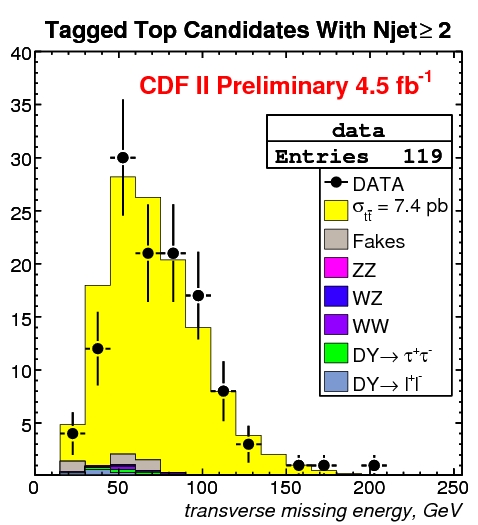I feel honored by having had a chance to study the first few tens of top quark events that physicists have been able to produce, and yet I regret that during the last few years I have been unable to put my hands on the much larger datasets collected by the CDF experiment.
What were once only few tens of clean single-lepton top pair decays, or just handfuls of dilepton top pair decays, have become hundreds, or even thousands, of candidates. This is due to three different, conspiring agents:
1. the fact that the dataset collected by CDF during Run I of the Tevatron proton-antiproton collider consisted in 100 inverse picobarns of data, while now during Run II (started in 2002 and still ongoing) CDF has already bagged more than 6 inverse femtobarns (60 times more data);
2. the fact that the beam energy is about 10% higher since the start of Run II, which increases the top pair-production cross section by 30% by virtue of the large mass of the top quark and the consequent rarity of these high-energy collisions;
3. the fact that the upgrades to the CDF detector before the start of Run II have increased the acceptance to energetic electrons and muons, thus strongly increasing the frequency of accepted top pair decays into leptons.
It should not therefore appear surprising that CDF can now produce plots such as the one below, which shows more than a hundred top quark candidates in a super-clean sample. Maybe unsurprising, and maybe not even exciting any more, now that the top quark is a very well-known fermion, whose mass is known to better than 0.7% uncertainty thanks to D0 and CDF mass measurements. But still, to me, plots such as this are fascinating.

In the figure you see the distribution of the missing transverse energy of dileptonic top pair candidates, which CDF extracted from 4.5 inverse femtobarns of data. The yellow histogram shows the fraction of signal events, while the other colors describe the small background contributions from Drell-Yan, WW, fake leptons, and Z decays to tau lepton pairs. From the above dataset the top pair cross section has been measured with a precision better than 20%.
I do not know about you, but those black points obeying our modeling of top production make me drool. Am I a pervert ?



Comments